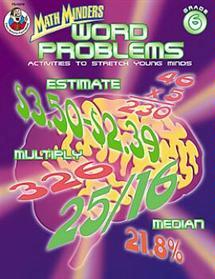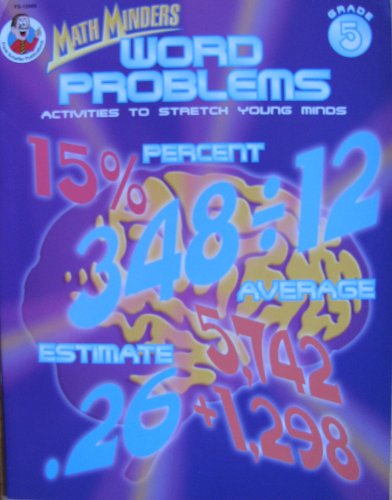-
Word Problems, Grade 6: Activities to Stretch Young Minds
Raymond Bottom, Tani Brooks Johnson
Paperback (Frank Schaffer Publications, Feb. 5, 1998)Math Minders provide students with the self-confidence they need to succeed in math. Students learn one step at a time, reviewing skills learned in earlier grades then moving to skills appropriate for their grade level. They progress gradually, giving them the constant feeling of success! Activities allow students to relate math to their everyday lives, giving math meaning and their studies a purpose. Vocabulary is kept at a level appropriate for each grade level to help ensure success. A variety of fun and simple formats help maintain a high level of student interest. Perfect for home or school, or to reinforce any existing math program. Z
Z
-
Word Problems, Grade 5: Activities to Stretch Young Minds
Robyn Silbey
Paperback (Frank Schaffer Publications, March 15, 1998)Math Minders provide students with the self-confidence they need to succeed in math. Students learn one step at a time, reviewing skills learned in earlier grades then moving to skills appropriate for their grade level. They progress gradually, giving them the constant feeling of success! Activities allow students to relate math to their everyday lives, giving math meaning and their studies a purpose. Vocabulary is kept at a level appropriate for each grade level to help ensure success. A variety of fun and simple formats help maintain a high level of student interest. Perfect for home or school, or to reinforce any existing math program. W
W
-
More Mini Mathematical Murder Mysteries: 16 Activities to Stretch and Engage Ages 13-15
Jill Whieldon
Paperback (Tarquin Group, Oct. 1, 2012)We all like to think we can solve a murder given the right clues. Here’s another chance to use mathematics skills to identify “whodunnit” - following the great success of the first book in the series Mini Mathematical Murder Mysteries. The students are given the data or a diagram to solve a “problem” – which is always which of various characters is a murderer. To find out, the student must solve all or most of the questions on the sheet to identify wrong answers as well as correct ones. Problems are staged, so there is an element of suspense for the individual…and racing between students to solve the mystery. The topics covered in this book are appropriate for ages 12-14 years. The tasks have been used successfully with older pupils too as a reminder of topics covered previously. They would also be suitable for younger pupils who have met the appropriate language and content. They are likely to take about 40 minutes but this will depend on the ability of the class to coordinate the different aspects of each task. The book is aimed at both teachers and parents. Teachers This is a set of consolidation resources rather than a teaching tool. They have worked well with a variety of classes, often putting the students in pairs to enable them to talk about the methods they’re using while they solve the “murder”. The author has found that their cooperative skills have improved as has their ability to plan and delegate in a bid to “win”. Parents Much more fun than having endless mathematics exercises to trawl through! Children will engage with the mathematics here presented in an entertaining way. Ideal for use in revision or other consolidation exercises. They are also great fun for after school clubs such as mathematics clubs, seeking to run short activities.
-
Mini Mathematical Murder Mysteries: A Collection of Blackline Masters for ages 11-14
Jill Whieldon
Paperback (Tarquin Group, Sept. 1, 2011)We all like to think we can solve a murder given the right clues. Here’s a chance to use mathematics skills to identify “whodunit” for ages 12-14. The students are given the data or a diagram to solve a “problem” – using blackline masters - which of various characters is a murderer. To find out, the student must solve all or most of the questions on the sheet to identify wrong answers as well as correct ones. Problems are staged, so there is an element of suspense for the individual…and racing between students to solve the mystery. The topics covered in this book are all appropriate for ages 11-13. The tasks have been used successfully with older pupils too as a reminder of topics covered previously. They would also be suitable for younger pupils who have met the appropriate language and content. They are likely to take about 40 minutes but this will depend on the ability of the class to coordinate the different aspects of each task. For ages 13-15 see the sister titles More Mini Mathematical Murder Mysteries. The book is aimed at both teachers and parents. X
X